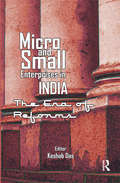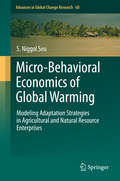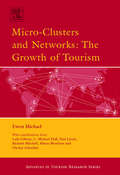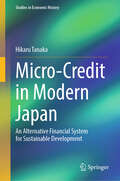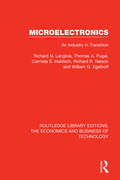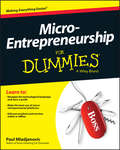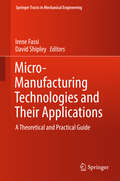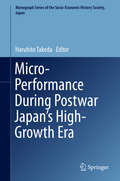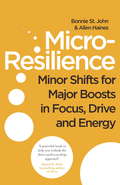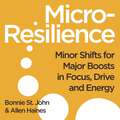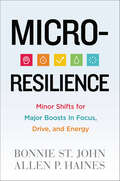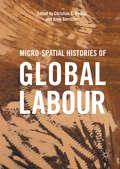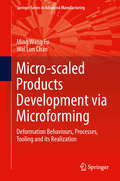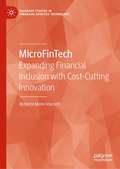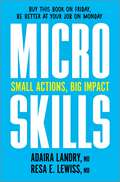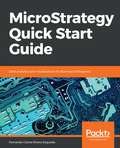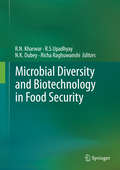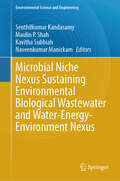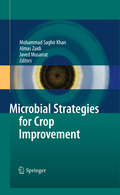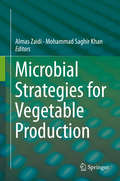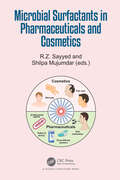- Table View
- List View
Micro and Small Enterprises in India: The Era of Reforms
by Keshab DasThis book presents a set of analytical and deeply policy-oriented articles on the dynamics of growth and performance of micro and small enterprises in India during the period of reforms. It provides fairly detailed analyses of policy changes for the micro and small enterprises secotr as well as empirical analyses of performance and efficiency of the unorganised manufacturing sector. it examines a range of emerging and persistent complex issues facing this crucial sector including credit, exports, trade regulations, capacity building, subcontracting, clustering, entrepreneurship and rural industrialisation. Focusing on the constraints facing this sector even during the economic reforms, most of the articles analyse how and why special attention, particularly by the state, needs to be paid towards enhancing firm competitiveness. Broad-basing the benefits of policy interventions to the overwhelmingly present yet left out micro enterprises, including rural areas, forms an important concern. This volume attempts to critically examine critical areas of intervention that could open up possibilities of developing a strong micro and small enterprises sector in India.
Micro-Behavioral Economics of Global Warming
by S. Niggol SeoThis book presents a foundation for studying the micro-behavioral economics of global warming. The author develops an empirical model, named the Geographically-scaled Micro econometric model of Adapting Portfolios (G-MAP) in response to climatic changes and risks. The G-MAP model is applied to observed decisions of agricultural and natural resource enterprises in Sub-Saharan Africa and South America. The author describes the five applications of the model: the G-MAP animal species, the G-MAP agricultural systems, the G-MAP natural resource enterprises, the G-MAP climate risk, and the G-MAP public adaptations. The micro-behavioral economics of global warming and the G-MAP models are evaluated against the three alternative modeling traditions: The first is the Agro-Economic Models (AEM) based on crop simulations of selected crops under elevated CO2 conditions; The second is a family of econometric studies of grain yield changes caused by yearly weather fluctuations; The third is the Agro-Ecological Zone (AEZ) method hinged crucially on the AEZ classifications of ecosystems. The author offers a refreshing look at the traditional economics of global warming, unraveling a broad array of adaptation strategies adopted by managers of agricultural and natural resource enterprises in Sub-Saharan Africa and South America. The book demonstrates that the micro-behavioral economics dynamically integrates multiple disciplines in a cohesive way - including economics, psychology, climate science, ecosystem studies, agronomy and animal science - into the decision-making framework of an individual agent. The G-MAP models provide a guide map of adaptation strategies for the humanity's enduring journey of battling global climatic changes in this century and beyond.
Micro-Clusters and Networks (Routledge Advances In Tourism Ser.)
by Ewen MichaelThis book introduces a new approach to the analysis and management of growth in small tourism markets for regional and rural locations. It recognizes from the outset that the vast bulk of the tourism industry’s product is delivered by small business enterprises and that many of these are located outside of metropolitan areas. Its central premise is that a myriad of small-scale clusters can provide an effective means to establish a local competitive advantage in tourism activities based on the resources of existing communities. The book brings together contemporary views of the potential of clustering theory to promote development in micro-markets, within the paradigm of competition, to create a new framework for regional development that might serve to enhance the growth of small-scale tourism destinations.Microclusters and Networks provides a theoretical explanation of how and why micro-clusters come about, with chapters by specialist authors to illustrate examples of their practice in the real world; but it goes further to demonstrate not only why they work but also how community members interact to form successful clusters. The incorporation of networking theory provides the means to explain the role of local community interaction in delivering successful social outcomes. The analysis that is provided clearly has applications for many industries beyond the development of rural and regional tourism destinations.
Micro-Credit in Modern Japan: An Alternative Financial System for Sustainable Development (Studies in Economic History)
by Hikaru TanakaJapanese society believes they enjoy socio-economic equality. While industrialization tends to make gap between rich and poor, most of Japanese are proud of themselves as being middle class in the first Asian industrialized country. In fact, post WW2 Japanese economic miracle made Japan rich and equalized. High personal saving ratio supported the economic development in those days as if it’s a proof of Rostow’s take-off model. Japanese saving rate had jumped high level around the beginning of 20th century, which was the time of their industrialization taking place. This book shows the savings was not only rich’s accumulation of wealth but ordinary citizen’s daily spares. The spare money helped whole nation’s economic development, especially supported relatively small farmers and self-employed workers. The personal small savings became huge funds for the basis of modern Japanese micro-credit and emergency bailout loan. Postal Savings Bank and nationwide cooperatives played the role in managing. This financial network was independent from ordinary financial system composed of private banks and securities market, and complement its function. The personal small savings funds in Japanese economy saved its society from various type of calamity and supported economic equalization as alternative financial system which acted as Not-for-Profit enterprises.
Micro-Electronics: An Industry in Transition (Routledge Library Editions: The Economics and Business of Technology #27)
by Thomas Pugel Richard Langlois Carmela S. Haklisch Richard R Nelson William EgelhoffOriginally published in 1988 this book was the culmination of 7 years of research in micro-electronics by the Center for Science and Technology Policy in New York. It includes original comparative study of corporate strategy in American, Japanese, and European firms, as well as an account of the evolution of technical alliances. It provides a detailed examination of the global micro-electronics industry in all its aspects - technological, economic, strategic and institutional and goes beyond organizing and presenting the facts to offer new perspectives, analyses and opinions.
Micro-Entrepreneurship For Dummies
by Paul MladjenovicTired of the 9-to-5 grind and want a way to earn or to supplement your income? Easy.The media has named the growing trend toward micro-entrepreneurship "the Rise of the Creative Class," "the Gig Life," or "the freelance economy." All of those refer to the nearly 4 million workers who were self-employed this past year, and millions of others who currently supplement their income with freelance work. While the trend has been spotted before, there's one stark difference between micro-entrepreneurs today and the "Free Agent Nation" citizens of the late '90s: technology. Micro-Entrepreneurship For Dummies shows you how to navigate this confusing technological landscape in order to make a contributable profit.Micro-Entrepreneurship For Dummies aids you in making the best use of micro-entrepreneurial platforms, with helpful advice that includes information on signing up for and selling products on websites such as Airbnb, Craigslist, Taskrabbit, Uber, and Etsy.Micro-enterprise, using online platforms to sell products or services,??is a proven way to earn extra money and supplement household incomeIn today's struggling economy, the importance of self-run businesses and small enterprise is growing as more people take lower-paying jobs and need a little extra spending moneyShows you how to sign up for and sell products onlineMicro-Entrepreneurship For Dummies appeals to anyone looking to earn or supplement their income from home.
Micro-Manufacturing Technologies and Their Applications
by David Shipley Irene FassiThis book provides in-depth theoretical and practical information on recent advances in micro-manufacturing technologies and processes, covering such topics as micro-injection moulding, micro-cutting, micro-EDM, micro-assembly, micro-additive manufacturing, moulded interconnected devices, and microscale metrology. It is designed to provide complementary material for the related e-learning platform on micro-manufacturing developed within the framework of the Leonardo da Vinci project 2013-3748/542424: MIMAN-T: Micro-Manufacturing Training System for SMEs. The book is mainly addressed to technicians and prospective professionals in the sector and will serve as an easily usable tool to facilitate the translation of micro-manufacturing technologies into tangible industrial benefits. Numerous examples are included to assist readers in learning and implementing the described technologies. In addition, an individual chapter is devoted to technological foresight, addressing market analysis and business models for micro-manufacturers.
Micro-Performance During Postwar Japan's High-Growth Era
by Haruhito TakedaThe aim of this book is to analyze Japan's high-growth economy, in particular to clarify the kinds of changes in people's lives that were generated by high growth. The present volume focuses not on the macro-economic mechanisms that expanded the scale of the economy, but on the micro-economic changes that were effected in everyday life. The emergence of a mass consumption society as a result of economic growth suggests that people's lifestyles and consumer behavior changed in various ways. The first chapter focuses on the apparel industry's expanding market as it corresponded to changes in consumer behavior. Even as consumer life became more comfortable and abundant, consumers were becoming uneasy about the environmental deterioration associated with high growth. The second chapter examines how the Japanese government addressed emissions regulations while drawing on the lessons of America's experience with the same issue. The change in industrial structure brought about by economic growth inevitably resulted in the decline of other industries. Chief among these was the coal-mining industry, which, with the onset of a full-scale energy revolution, lost its role as energy supplier owing to the import of cheap crude oil. The third chapter discusses the government's industrial policies as they addressed the coal industry's adjustment in the high-growth era, concluding that they reduced such problems as stagnation, unemployment, and local industrial decline. The adjustments in employment practices contributed positively to the gradual shift of labor from declining industries to growth industries. The fourth chapter investigates changes in labor management in the steel industry, which was one of the high-growth era's leading industries. This publication will serve as a valuable resource for those who are interested not only in the post-war history in Japan but also in high growth economies in recent East Asia.
Micro-Resilience: Minor Shifts for Major Boosts in Focus, Drive and Energy
by Bonnie St. John Allen P. Haines'Micro-Resilience is a powerful book that will help you rethink the drive-until-you-drop approach to work. By re-framing your thinking, you can learn to learn bounce back from setbacks and create a life of power and meaning' Daniel Pink, author of Drive and To Sell is HumanAs leadership consultants and executive trainers, Bonnie St. John and Allen Haines have heard the same complaints from clients for years; periodic burnout, lack of focus and low energy. So they dug into the latest research on neuroscience, psychology and physiology looking for big answers. Instead they found small answers; proof that small adjustments in daily routines, including thought patterns, food and drink, rest and movement can fight the forces that sap our energy and store focus and drive. They call these amazing efficient restorative techniques 'micro-resilience.'Thousands of men and women from all walks of life have already found effortless ways to incorporate these little changes into the busiest of schedules. Dozens of entertaining anecdotes from real people using micro-resilience demonstrate that when our brains fire faster, our energy increases and we can cope with almost any surprise, pressure or crisis, no matter how big or small.
Micro-Resilience: Minor Shifts for Major Boosts in Focus, Drive and Energy
by Bonnie St. John Allen P. Haines'Micro-Resilience is a powerful book that will help you rethink the drive-until-you-drop approach to work. By re-framing your thinking, you can learn to learn bounce back from setbacks and create a life of power and meaning' Daniel Pink, author of Drive and To Sell is HumanAs leadership consultants and executive trainers, Bonnie St. John and Allen Haines have heard the same complaints from clients for years; periodic burnout, lack of focus and low energy. So they dug into the latest research on neuroscience, psychology and physiology looking for big answers. Instead they found small answers; proof that small adjustments in daily routines, including thought patterns, food and drink, rest and movement can fight the forces that sap our energy and store focus and drive. They call these amazing efficient restorative techniques 'micro-resilience.'Thousands of men and women from all walks of life have already found effortless ways to incorporate these little changes into the busiest of schedules. Dozens of entertaining anecdotes from real people using micro-resilience demonstrate that when our brains fire faster, our energy increases and we can cope with almost any surprise, pressure or crisis, no matter how big or small.
Micro-Resilience: Minor Shifts for Major Boosts in Focus, Drive, and Energy
by Bonnie St. JohnLearn powerful, science-based techniques to boost focus, drive and energy hour-by-hour throughout the day -- every day. As leadership consultants and executive trainers, Bonnie St. John and Allen P. Haines have heard the same complaints from clients for years; periodic burnout, lack of focus and low energy. So they dug into the latest research on neuroscience, psychology and physiology looking for big answers. Instead they found small answers; proof that small adjustments in daily routines, including thought patterns, food and drink, rest and movement can fight the forces that sap our energy and store focus and drive. They call these amazing efficient restorative techniques "micro-resilience." Thousands of men and women from all walks of life have already found effortless ways to incorporate these little changes into the busiest of schedules. Dozens of entertaining anecdotes from real people using micro-resilience demonstrate that when our brains fire faster, our energy increases and we can cope with almost any surprise, pressure or crisis.
Micro-Spatial Histories of Global Labour
by Anne Gerritsen Christian G. De VitoThis volume suggests a new way of doing global history. Instead of offering a sweeping and generalizing overview of the past, we propose a 'micro-spatial' approach, combining micro-history with the concept of space. A focus on primary sources and awareness of the historical discontinuities and unevennesses characterizes the global history that emerges here. We use labour as our lens in this volume. The resulting micro-spatial history of labour addresses the management and recruitment of labour, its voluntary and coerced spatial mobility, its political perception and representation and the workers' own agency and social networks. The individual chapters are written by contributors whose expertise covers the late medieval Eastern Mediterranean to present-day Sierra Leone, through early modern China and Italy, eighteenth-century Cuba and the Malvinas/Falklands, the journeys of a missionary between India and Brazil and those of Christian captives across the Ottoman empire and Spain. The result is a highly readable volume that addresses key theoretical and methodological questions in historiography.
Micro-scaled Products Development via Microforming
by Ming Wang Fu Wai Lun Chan'Micro-scaled Products Development via Microforming' presents state-of-the-art research on microforming processes, and focuses on the development of micro-scaled metallic parts via microforming processes. Microforming refers to the fabrication of microparts via micro-scaled plastic deformation and presents a promising micromanufacturing process. When compared to other micromanufacturing processes, microforming offers advantages such as high productivity and good mechanical properties of the deformed microparts. This book provides extensive and informative illustrations, tables and photos in order to convey this information clearly and directly to readers. Although the knowledge of macroforming processes is abundant and widely used in industry, microparts cannot be developed by leveraging existing knowledge of macroforming because the size effect presents a barrier to this knowledge transfer. Therefore systematic knowledge of microforming needs to be developed. In tandem with product miniaturization, the demand on microparts has been increased for their wide applications in many industries, including automotive, bio-medical, aerospace and consumer electronics industries. Micromanufacturing technologies have thus become more and more important. This book is intended for postgraduates, manufacturing engineers and professionals working in the areas of manufacturing and materials processing.
MicroEconomics: A Basic Perspective
by Roger MackFor many of you, economics is among the most feared and most challenging courses that you will enroll in during your college experience. Despite this, economics is also a subject matter that will stay with you, be actively used and may well have the most impact throughout your life. Economics involves a way of thinking about choices and outcomes. In a very real sense, both the teaching and the learning of economics is "work in progress." Your choices and the choices of others around you, the resulting outcomes, and the opportunities, both chosen and given up, greatly determine much of the quality of your life.
MicroFinTech: Expanding Financial Inclusion with Cost-Cutting Innovation (Palgrave Studies in Financial Services Technology)
by Roberto Moro-ViscontiMicrofinance is a renowned albeit controversial solution for giving financial access to the unbanked, even if micro-transactions increase costs, limiting outreach potential. The economic and financial sustainability of Microfinance Institutions (MFIs) is a prerequisite for widening a potentially unlimited client base. Automation decreases costs, expanding the outreach potential, and improving transparency and efficiency. Technological solutions range from branchless mobile banking to geo-localization of customers, digital/social networking for group lending, blockchain validation, big data, and artificial intelligence, up to “MicroFinTech” - FinTech applications adapted to microfinance. Of interest to both scholars, students, and professors of financial technology and microfinance, this book examines these trendy solutions comprehensively, going beyond the existing literature and showing potential applications to the traditional sustainability versus outreach trade-off.
MicroFridge: The Concept
by John DeightonRobert Bennett, who has a Master's degree in engineering, wants to exploit his idea to combine a refrigerator, freezer, and 500-watt microwave into an 87-pound, 4-foot-high appliance to sell to college students. Bennett must decide which markets to serve, which competitors he must contend with, with whom to collaborate, and what core capabilities to build.
MicroSkills: Small Actions, Big Impact
by Adaira Landry M.D. Resa E. Lewiss M.D.The promise of this book is simple: if you buy this book on Friday, you will be better at your job by Monday.MicroSkills is built on one core, easy-to-learn principle: every big goal, complicated task, healthy habit, and, yes, even what we think of as character traits, can be broken down into small, learnable, skills that can be practiced, and incorporated real-time. We call these: MicroSkills.As award winning physicians, educators, and mentors we hear the gamut of challenges with navigating the workplace. And when we learn a lesson we often wish we had learned it earlier. MicroSkills is packed with the privileged information that you want delivered to you as efficiently as possible.In MicroSkills you will learn How to build your career without breaking yourself How to manage your task list to get work done How to build and maintain your professional reputation How to become a subject matter expert How to grow and nurture your network How to become a better communicator and so much more...MicroSkills is the gift we wish we had received early in our careers.
MicroStrategy Quick Start Guide: Data analytics and visualizations for Business Intelligence
by Fernando Carlos Rivero EsquedaBuild reporting applications and dashboards using the different MicroStrategy objectsKey FeaturesLearn the fundamentals of MicroStrategyUse MicroStrategy to get actionable insights from your business dataCreate visualizations and build intuitive dashboards and reportsBook DescriptionMicroStrategy is an enterprise business intelligence application. It turns data into reports for making and executing key organization decisions. This book shows you how to implement Business Intelligence (BI) with MicroStrategy. It takes you from setting up and configuring MicroStrategy to security and administration.The book starts by detailing the different components of the MicroStrategy platform, and the key concepts of Metadata and Project Source. You will then install and configure MicroStrategy and lay down the foundations for building MicroStrategy BI solutions. By learning about objects and different object types, you will develop a strong understanding of the MicroStrategy Schema and Public Objects. With these MicroStrategy objects, you will enhance and scale your BI and Analytics solutions.Finally, you will learn about the administration, security, and monitoring of your BI solution.What you will learnSet up the MicroStrategy Intelligence Server and client toolsCreate a MicroStrategy metadata repository and your first ProjectExplore the main MicroStrategy object types and their dependencies Create, manipulate, and share ReportsCreate and share DashboardsManage Users and GroupsWho this book is forThis book is for Business Intelligence professionals or data analysts who want to get started with Microstrategy. Some basic understanding of BI and data analysis will be required to get the most from this book.
MicroStrategy: Accounting for Cryptocurrency
by Annelena Lobb Jonas HeeseOn February 15, 2021, Alina Moss, an analyst who covered the technology company MicroStrategy, pondered a rise in MicroStrategy's share price. Moss had dialed into the company earnings call. When it ended, Moss had more questions than answers. MicroStrategy had recorded a meager operating income of $390,000 in the fourth quarter of fiscal year 2020, yet its non-GAAP operating income was $30.1 million and its share price had climbed 160% during the period. In 2020, MicroStrategy had invested heavily in Bitcoin, and its CEO Michael Saylor said that MicroStrategy would continue using Bitcoin as its primary treasury reserve asset. The accounting treatment of cryptocurrencies was murky as standard setters had not yet decided how firms should account for cryptocurrencies, leaving it up to companies to determine the appropriate accounting. MicroStrategy treated cryptocurrencies as intangible assets on its financial statements, as did many other firms. Accounting rules for intangible assets required reporting downward price shifts as impairment losses but did not require the recording of upswings in price. MicroStrategy disclosed a significant decline in net income as compared to the fourth quarter of 2019 because of impairment losses on Bitcoin. How well was MicroStrategy really doing? Did the current accounting treatment for cryptocurrencies make sense for companies holding Bitcoin? How should investors assess firms' Bitcoin investments?
Microbial Diversity and Biotechnology in Food Security
by R. S. Upadhyay R. N. Kharwar N. K. Dubey Richa RaghuwanshiThe roles of microbes in agriculture, industry and environment have been the point of interest since long time for their potential exploitation. Although only a fraction of microbial diversity was accessed by microbiologists earlier for harnessing them owing to limited techniques available. The molecular techniques have opened new vistas to access the wide field of the unexplored microbes and their exploitation for useful genes and novel metabolites. Sincere efforts have been made in biotechnology using microbes leading to improve our life with respect to agriculture and people health. This comprehensive volume covers different aspects of microbial biotechnology and its management in sustainable agriculture for food security and improved human health. The book comprises four sections: Endophytes and Mycorrhizae, Microbial Diversity and Plant Protection, Microbial Functions and Biotechnology, and Microbes and the Environment, which contain 53 chapters. The book examines the aspects on endophytes and mycorrhizae, bioactive compounds, growth promoting microorganisms, disease management with emphasis on biocontrol, genetics of disease resistance, microbial enzymes, advances in potential of microbes and their industrial as well as pharmaceutical applications. In addition, the use of botanicals, and the etiology and management of medicinal and aromatic plants in the post harvest management have been reviewed in greater depth for the benefit of teaching and research community The biotechnological developments using microbe potential have enabled us combat the environment and human health problems worldwide in ecofriendly manner. We are sure that this volume will be highly useful to all those concerned with fungi, bacteria, viruses and their biology, including environmental and public health officers and professionals in the field of interest. The volume is an exhaustive coverage of almost all the aspects of microbial biology and biotechnology.
Microbial Niche Nexus Sustaining Environmental Biological Wastewater and Water-Energy-Environment Nexus (Environmental Science and Engineering)
by Maulin P. Shah Senthilkumar Kandasamy Kavitha Subbiah Naveenkumar ManickamIn most of the industries, industrial effluent treatment plants are playing vital roles to ensure the efficient management of industrial effluent for supporting sustainable development of our society. Due to the technological development, new concepts about future wastewater management are being incorporated by process industries in the whole world, including recyclable resources and energy/nutrient recovery from industrial effluent, etc. However, conventional treatment methods including biotechnological methods used in treatment plants are facing a lot of difficulties due to the strict discharging norms and coming out of new-fangled pollutants. Recently, a novel concept microbial niche nexus sustaining biological wastewater treatment was introduced, which can accomplish the significant removal of toxic emerging pollutants by different microbial communities, with the concern of other components like integrated and healthy ecosystem. The book focuses on research related to future potential and progress of microbial niche-based environmental biotechnology such as microbial enrichment, microbial function, system design, new technological developments and its applications. Besides, the book reviews important interconnections between water, energy, and the environment as security in water and energy, and the environment is associated with human beings, natural resources, economic, and environmental sustainability. In addition, the book describes innovative green technologies with the aim of enhancing the present state-of-the-art technologies in the various fields like water, energy, the environment, and the related potential fields of industrial wastewater treatment.
Microbial Strategies for Crop Improvement
by Javed Musarrat Almas Zaidi Mohammad Saghir KhanThis book presents the multidisciplinary nature and the many fascinating aspects of microbiological approaches for crop improvement in both conventional and stressed soils where quality and safety are the key concerns. The major goal is to provide a cross-section of the latest accomplishments and envisaged future directions in these areas. It gives a holistic view of the basic concepts and practical utility of microbes and thus presents an all-inclusive contemporary treatise on strategic aspects of the diverse microbial communities providing solutions to oodles of customary agronomic problems. This book benefits people working in the area of agronomy, biotechnology, environmental biology, microbiology, plant physiology, plant protection and soil science. The contributions by eminent academicians and professionals ensure a good equilibrium between theory and practice without compromising the basic conceptual framework of the concerned subject.
Microbial Strategies for Vegetable Production
by Almas Zaidi Mohammad Saghir KhanThis book provides a comprehensive information on basic and applied concepts of microbesial strategies adopted for the improvement of vegetables grown in various production systems. The beneficial role of soil microbes including plant growth promoting rhizobacteria (PGPR), nitrogen fixers, and phosphate-solubilizing bacteria in the improvement of vegetables grown both in normal and contaminated soils is discussed. The role of PGPR in tomato production is dealt separately. The impact of heavy metals on different vegetables and abatement of metal toxicity following metal tolerant PGPR and their consequential impact on vegetables grown in metal polluted soil is discussed. Moreover, recent advances in the management of vegetable diseases employing PGPR are addressed. This volume is therefore of special interest to both academics, professionals and practitioners working in the field of vegetable farming/horticulture, microbiology and plant protection sciences.
Microbial Surfactants in Pharmaceuticals and Cosmetics
by R. Z. Sayyed Shilpa MujumdarBiosurfactants and bioemulsifiers are considered green molecules as they are produced from microbes and are easily degradable as compared to surfactants. They are suitable due to properties such as low toxicity, tolerance to a wide-range pH level and temperature, high surface activity, biodegradability, excellent emulsifying and demulsifying ability. While, caution and care should be exercised in its widespread usage, they are likely to replace chemical surfactants.The book focuses on biosurfactant production from various bacteria, diversity of biosurfactant producing bacteria, and the industrial need of biosurfactants. Fields such as pharmacy, medicine, and cosmetics are covered. It is presented in an easy-to-understand manner, and is well illustrated, and comprises protocols and recent data on the production, formulation and commercialization and other aspects of biosurfactants and bioemulsifiers.
